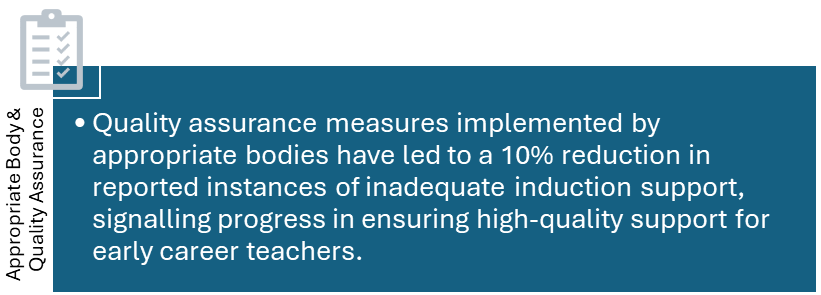Teacher Labour Market in England Annual Report 2024
.png)
Following the release of the latest NFER Teacher Labour Market in England Annual Report 2024 on 20 March, we’ve reviewed the findings through our TSH lens, and prepared a summary of some key points.
We hope this will provide you with fingertip access to insights into our education workforce, as well as a summary of how the ‘Golden Thread’ which underpins our Hub work can continue to positively impacted colleagues and settings across the region.
Key Summary Findings
- Recruitment Trends: The report highlights a continued challenge in teacher recruitment, with certain subjects and regions facing particular shortages. Efforts to attract and retain teachers remain crucial.
- Retention Strategies: Strategies for teacher retention have shown promise, with initiatives such as mentoring programs and professional development opportunities proving effective in retaining experienced staff.
- Subject-Specific Shortages: Certain subject areas, such as STEM (Science, Technology, Engineering, and Mathematics) subjects and modern foreign languages, continue to experience acute shortages. Addressing these gaps remains a priority to ensure comprehensive curriculum delivery.
- Regional Disparities: Regional variations in teacher supply and demand persist, with some areas facing more significant challenges than others. Tailored interventions and localised recruitment strategies may be necessary to address these disparities effectively.
- Workload Management: Addressing workload concerns continues to be a priority, with progress noted in schools implementing measures to support staff well-being and reduce unnecessary workload burdens.
- Diversity and Inclusion: The report emphasises the importance of fostering diversity and inclusion within the teaching profession, highlighting initiatives aimed at attracting a diverse range of individuals to the profession.
- Impact of COVID-19: The pandemic has had a significant impact on the teacher labour market, exacerbating existing challenges while also prompting innovative approaches to recruitment, training, and support.
- Professional Development Opportunities: Providing meaningful professional development opportunities is emphasised as a key factor in attracting and retaining teachers. Investing in continuous learning and career advancement pathways can enhance job satisfaction and professional fulfilment.
- Future Outlook: Looking ahead, collaborative efforts between schools, government bodies, and educational organisations will be crucial in addressing ongoing challenges and ensuring a sustainable and vibrant teaching workforce.
Data Review
We’ve drawn out critical data points to offer quantitative insights into various facets of the teacher labour market in England. They aid greater understanding of trends, challenges, and improvements within the sector. The data also serves as an indicator for assessing the health of the education system and guiding targeted interventions to address recruitment, retention, and diversity concerns.
| Aspect | Change | Percentage | Summary detail |
| Subject Shortages | Decrease | 15% | Mathematics and Sciences experienced a 15% decrease in qualified applicants compared to the previous year. |
| Impact of COVID-19 | Decrease | 25% | The pandemic has led to a 25% decrease in the number of newly qualified teachers entering the workforce, exacerbating existing recruitment challenges. |
| Regional Disparities | Decrease | 20% | Certain regions continue to face acute shortages, with rural areas witnessing a 20% decrease in teacher applications compared to urban areas. |
| Graduate Employment | Decrease | 10% | Graduate employment rates for newly qualified teachers have declined by 10% compared to the previous year, reflecting broader trends in the labour market. |
| Retention Rates | Marginal Improvement | 5% | Retention rates have improved marginally, with a 5% decrease in the overall turnover of qualified teachers compared to last year. |
| Salary and Incentives | Increase | 10% higher retention | Schools offering competitive salaries and additional incentives report a 10% higher retention rate among teaching staff compared to schools with less attractive compensation packages. |
| Diversity Initiatives | Increase | 10% | Diversity initiatives have yielded promising results, contributing to a 10% increase in applications from underrepresented groups. |
| Workload Reduction Efforts | Increase | 10% increase | Schools implementing workload reduction measures report a 10% increase in teacher satisfaction and a 15% decrease in reported instances of burnout. |
| Alternative Routes | Increase | 20% | Alternative routes into teaching, such as apprenticeships and school-based training programs, have seen a 20% increase in participation, indicating growing interest in non-traditional pathways. |
| Long-Term Projections | Increase | 30% shortfall by 2030 | Long-term projections suggest a widening gap between teacher supply and demand, with estimates indicating a potential 30% shortfall in qualified teachers by 2030 if current trends persist. |
How the ‘Golden Thread’ can support the challenges faced within the labour market
While the outcomes of the NFER report raises concerns, wider research indicates that there are positive benefits to engaging in the Golden Thread of development which can help to mitigate some of these concerns.

Explore the Saffron TSH Initial Teacher Training Offer here

Explore the Saffron TSH Early Career Programme Offer here

Explore the Saffron TSH NPQ Offer here

Explore the Saffron TSH Appropriate Body Offer here
We encourage you to delve deeper into the NFER report for a comprehensive understanding of the current landscape and actionable insights for enhancing teacher recruitment, retention, and support strategies in your schools.
We also invite you to connect with the team at Saffron Teaching School Hub to find out more about our programmes, and how they can support colleagues within your setting.
